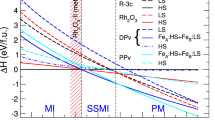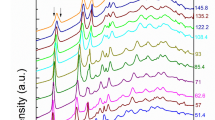Abstract
The mineral magnetite (Fe3O4) undergoes a complex structural distortion and becomes electrically insulating at temperatures less than 125 kelvin. Verwey proposed in 1939 that this transition is driven by a charge ordering of Fe2+ and Fe3+ ions1, but the ground state of the low-temperature phase has remained contentious2,3 because twinning of crystal domains hampers diffraction studies of the structure4. Recent powder diffraction refinements5,6,7 and resonant X-ray studies8,9,10,11,12 have led to proposals of a variety of charge-ordered and bond-dimerized ground-state models13,14,15,16,17,18,19. Here we report the full low-temperature superstructure of magnetite, determined by high-energy X-ray diffraction from an almost single-domain, 40-micrometre grain, and identify the emergent order. The acentric structure is described by a superposition of 168 atomic displacement waves (frozen phonon modes), all with amplitudes of less than 0.24 ångströms. Distortions of the FeO6 octahedra show that Verwey’s hypothesis is correct to a first approximation and that the charge and Fe2+ orbital order are consistent with a recent prediction17. However, anomalous shortening of some Fe–Fe distances suggests that the localized electrons are distributed over linear three-Fe-site units, which we call ‘trimerons’. The charge order and three-site distortions induce substantial off-centre atomic displacements and couple the resulting large electrical polarization to the magnetization. Trimerons may be important quasiparticles in magnetite above the Verwey transition and in other transition metal oxides.
This is a preview of subscription content, access via your institution
Access options
Subscribe to this journal
Receive 51 print issues and online access
$199.00 per year
only $3.90 per issue
Buy this article
- Purchase on Springer Link
- Instant access to full article PDF
Prices may be subject to local taxes which are calculated during checkout




Similar content being viewed by others
References
Verwey, E. J. W. Electronic conduction of magnetite (Fe3O4) and its transition point at low temperatures. Nature 144, 327–328 (1939)
Walz, F. The Verwey transition: a topical review. J. Phys. Condens. Matter 14, R285–R340 (2002)
Coey, M. Condensed-matter physics: charge-ordering in oxides. Nature 430, 155–157 (2004)
Iizumi, M. et al. Structure of magnetite (Fe3O4) below the Verwey transition-temperature. Acta Crystallogr. B 38, 2121–2133 (1982)
Wright, J. P., Attfield, J. P. & Radaelli, P. G. Long range charge ordering in magnetite below the Verwey transition. Phys. Rev. Lett. 87, 266401 (2001)
Wright, J. P., Attfield, J. P. & Radaelli, P. G. Charge ordered structure of magnetite Fe3O4 below the Verwey transition. Phys. Rev. B 66, 214422 (2002)
Blasco, J., Garcia, J. & Subias, G. Structural transformation in magnetite below the Verwey transition. Phys. Rev. B 83, 104105 (2011)
Goff, R. J., Wright, J. P., Attfield, J. P. & Radaelli, P. G. Resonant X-ray diffraction study of the charge ordering in magnetite. J. Phys. Condens. Matter 17, 7633–7642 (2005)
Nazarenko, E. et al. Resonant X-ray diffraction studies on the charge ordering in magnetite. Phys. Rev. Lett. 97, 056403 (2006)
Joly, Y. et al. Low-temperature structure of magnetite studied using resonant X-ray scattering. Phys. Rev. B 78, 134110 (2008)
Bland, S. R. et al. Full polarization analysis of resonant superlattice and forbidden X-ray reflections in magnetite. J. Phys. Condens. Matter 21, 485601 (2009)
Lorenzo, J. E. et al. Charge and orbital correlations at and above the Verwey phase transition in magnetite. Phys. Rev. Lett. 101, 226401 (2008)
Seo, H., Ogata, M. & Fukuyama, H. Aspects of the Verwey transition in magnetite. Phys. Rev. B 65, 085107 (2002)
Jeng, H. T., Guo, G. Y. & Huang, D. J. Charge-orbital ordering and Verwey transition in magnetite. Phys. Rev. Lett. 93, 156403 (2004)
Jeng, H. T., Guo, G. Y. & Huang, D. J. Charge-orbital ordering in low-temperature structures of magnetite: GGA+U investigations. Phys. Rev. B 74, 195115 (2006)
van den Brink, J. & Khomskii, D. I. Multiferroicity due to charge ordering. J. Phys. Condens. Matter 20, 434217 (2008)
Yamauchi, K., Fukushima, T. & Picozzi, S. Ferroelectricity in multiferroic magnetite Fe3O4 driven by noncentrosymmetric Fe2+/Fe3+ charge-ordering: first-principles study. Phys. Rev. B 79, 212404 (2009)
Zhou, F. & Ceder, G. First-principles determination of charge and orbital interactions in Fe3O4 . Phys. Rev. B 81, 205113 (2010)
Fukushima, T., Yamauchi, K. & Picozzi, S. Ab initio investigations of Fe2+/Fe3+ bond dimerization and ferroelectricity induced by intermediate site/bond-centered charge ordering in magnetite. J. Phys. Soc. Jpn 80, 014709 (2011)
Yoshida, J. & Iida, S. X-ray-diffraction study on low-temperature phase of magnetite. J. Phys. Soc. Jpn. 42, 230–237 (1977)
Kasama, T., Church, N. S., Feinberg, J. M., Dunin-Borkowski, R. E. & Harrison, R. J. Direct observation of ferrimagnetic/ferroelastic domain interactions in magnetite below the Verwey transition. Earth Planet. Sci. Lett. 297, 10–17 (2010)
Attfield, J. P. Charge ordering in transition metal oxides. Solid State Sci. 8, 861–867 (2006)
Verwey, E. J. W. & Heilmann, E. L. Physical properties and cation arrangement of oxides with spinel structures. 1. Cation arrangement in spinels. J. Chem. Phys. 15, 174–180 (1947)
Anderson, P. W. Ordering and antiferromagnetism in ferrites. Phys. Rev. 102, 1008–1013 (1956)
Downward, L. et al. Universal relationship between magnetization and changes in the local structure of La1-xCaxMnO3: evidence for magnetic dimers. Phys. Rev. Lett. 95, 106401 (2005)
Yang, M. H. et al. Anion order in perovskite oxynitrides. Nat. Chem. 3, 47–52 (2011)
Ikeda, N. et al. Ferroelectricity from iron valence ordering in the charge-frustrated system LuFe2O4 . Nature 436, 1136–1138 (2005)
Yamada, Y., Wakabayashi, N. & Nicklow, R. M. Neutron diffuse-scattering in magnetite due to molecular polarons. Phys. Rev. B 21, 4642–4648 (1980)
Shepherd, J. P., Koenitzer, J. W., Aragon, R., Sandberg, C. J. & Honig, J. M. Heat-capacity studies on single-crystal annealed Fe3O4 . Phys. Rev. B 31, 1107–1113 (1985)
Acknowledgements
We thank C. Morrison for supplying code for electrical polarization calculations, J. Honig for provision of the magnetite sample, the Leverhulme Trust for financial support, and EPSRC and STFC for financial support and provision of continuing access to ESRF.
Author information
Authors and Affiliations
Contributions
J.P.A. and J.P.W. designed the study, data were collected and analysed by M.S.S. and J.P.W., and J.P.A. wrote the paper with contributions from M.S.S. and J.P.W.
Corresponding authors
Ethics declarations
Competing interests
The authors declare no competing financial interests.
Supplementary information
Supplementary Information
This file contains Supplementary Methods, Supplementary Figures 1-3 with legends, Supplementary Tables 1-7 and additional references. (PDF 960 kb)
Rights and permissions
About this article
Cite this article
Senn, M., Wright, J. & Attfield, J. Charge order and three-site distortions in the Verwey structure of magnetite. Nature 481, 173–176 (2012). https://doi.org/10.1038/nature10704
Received:
Accepted:
Published:
Issue Date:
DOI: https://doi.org/10.1038/nature10704
This article is cited by
-
Observation of an exotic insulator to insulator transition upon electron doping the Mott insulator CeMnAsO
Nature Communications (2023)
-
A study on Ti-doped Fe3O4 anode for Li ion battery using machine learning, electrochemical and distribution function of relaxation times (DFRTs) analyses
Scientific Reports (2022)
-
Coexisting Z-type charge and bond order in metallic NaRu2O4
Communications Materials (2022)
-
The electrical conductivity of Fe4O5, Fe5O6, and Fe7O9 up to 60 GPa
Physics and Chemistry of Minerals (2022)
-
Charge order textures induced by non-linear couplings in a half-doped manganite
Nature Communications (2021)
Comments
By submitting a comment you agree to abide by our Terms and Community Guidelines. If you find something abusive or that does not comply with our terms or guidelines please flag it as inappropriate.



